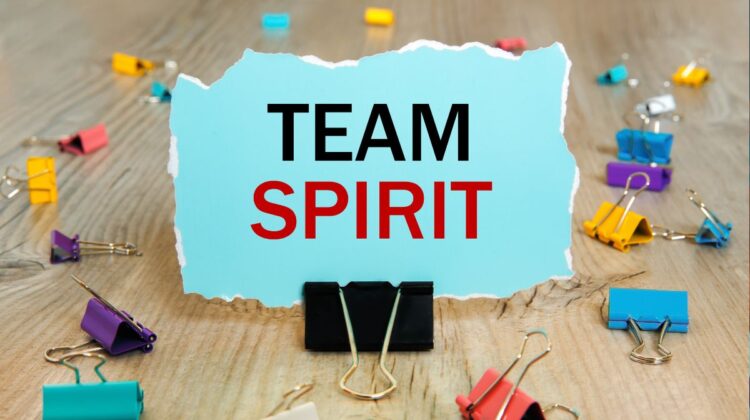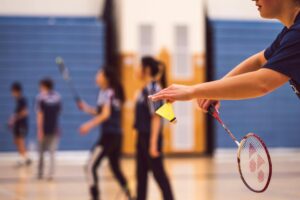
The school corridors, resonating with the clang of the lockers and the voices of students, are replaced by a cheering stadium. School sports teams, part of the curriculum, provide more than just an excuse for students to engage in physical training – they cement partnership, resilience, and leadership among students.
By wearing their customized high school sports team apparel, the athletes feel not only part of a more significant entity but also a shared vision and the same code of ethics.
On the sidelines of exciting fans’ cheers and the adrenaline associated with competition, students gain priceless lessons in teamwork, discipline, and sportsmanship. Apart from the excitement of accomplishments and the bitterness of defeat, school sports develop friendships that live on even after the closing whistle.
In this ever-changing environment, the students can discover their strengths, create lifelong friendships, and accept leadership challenges with perseverance and humility.
Let’s embark on a journey exploring how sports in schools can influence young minds so that they become the leaders of tomorrow. From the sweating fields to the resonating hall, the endeavor of a student-athlete is a growth process, friendship, and teamwork spirit that will last forever.
1. Fostering camaraderie through diverse team dynamics
School sports camaraderie is more than just unity; it is about recognizing and appreciating the diverse talents and backgrounds that each teammate adds. Such various outlooks enrich the teams’ culture and lead to more collaborative success.
Empathy in action
Take, for instance, a team of high school basketball players from different cultural backgrounds. The train features “cultural exchange“ situations where players might tell stories about their origins. Now, this exercise enhances collective motivation, increases mutual appreciation and reciprocal knowledge, and ensures the practical manifestation of empathy.
Players will help each other on the field and in their private problems, making the group a strong and friendly unit.
Strategic Communication
Effective communication within a team goes beyond discussing strategies or game plans. It involves open forums where team members express their aspirations, concerns, and feedback.
For instance, a soccer team might hold monthly team-building retreats focusing on non-sporting activities, fostering open communication. These sessions help identify individual and collective goals, making the team’s communication dynamic and multidimensional.
Camaraderie Beyond the Field
True camaraderie extends beyond practice sessions and matches. It’s about the shared experiences teams create through community service projects or supporting a team member in academic pursuits. These experiences solidify the sense of belonging and commitment to the team’s collective success, highlighting that camaraderie is built on shared values and mutual achievements.
School teams’ empathy, strategic communication, and camaraderie foster unity enhance performance, and prepare student-athletes for diverse social interactions and future leadership roles.
2. Developing Adaptive Leadership Skills in High School Sporting Events

Leadership in school sports breaks away from the traditional ideas of the leader being the one who commands and controls; it is the cultivation of these adaptive leaders who can excel in many situations and influence their team through example and innovation.
Innovative Decision-making
Think of a volleyball team playing against a skilled team in a crucial game. The captain, realizing the need for revision in strategy, teams up with a coach to introduce a new defensive formation different from the ones used by the team in the past. This decision, made under pressure and when seemingly all hope was lost, not only turned the match around but also showed the team the importance of adaptability and courage in leadership. It is proof of how influential sports leaders are the ones who can act on their feet and make tough calls in critical moments.
Empowering Communication
Listening is as essential as speaking when it comes to leadership. It is part of a track and field captain’s duties to give at least an hour a week to individual meetings with team members to inquire about their goals, concerns, and feedback. This inclusive communication practice builds a team environment where every member is heard and valued, resulting in a cohesive and motivated team.
This leadership style showcases how leaders motivate their teams through open and empathetic dialogues that include and act on the voices of all the team members.
Inspiring Motivation Beyond the Game
True leaders inspire their peers in competition and all facets of life. A soccer team leader organizes group study sessions and community clean-up projects, showing that leadership principles apply beyond the playing field. These actions reinforce the idea that the qualities of a good leader—responsibility, initiative, and a sense of community—benefit the team and the wider society. This holistic approach to leadership underscores the role of sports in developing well-rounded individuals who are prepared to lead in various contexts.
School sports programs can mold student-athletes into adaptable, empathetic leaders ready to face future challenges by focusing on innovative decision-making, empowering communication, and inspiring motivation beyond sports.
3. Transcending the Game: Lifelong Lessons from School Sports
School sports are much more than the sum of their scores; they are a powerful tool for imparting life lessons that outlive the game and sport, making a young athlete a champion in all fields of life.
Mastering Time Management
For student-athletes, there is no small job of balancing academics, sports, and their personal lives. Look at the story of a high school swimmer who manages a strict routine for training that is used to develop an intelligent time-management strategy with due dates and competition dates.
Such a system, used by her teammates, can help her enhance her academic performance and serve as an example for her peers that sports can teach functional organizational skills required in all spheres of life.
Goal setting with Precision
The process of setting and achieving goals is vividly demonstrated in school sports. A basketball team, for example, might set a series of incremental goals throughout the season, from improving free throw percentages to enhancing team cohesion during plays. This systematic approach to goal setting teaches student-athletes the importance of small, measurable objectives in realizing larger ambitions, a skill that translates directly to academic and professional success.
Cultivating Resilience Through Setbacks
The actual test of character often comes in moments of defeat. A cross-country team’s response to a disappointing season—analyzing performances, adjusting training methods, and doubling down on their commitment—exemplifies how setbacks in sports can foster resilience. This resilience, the ability to confront, adapt, and grow from challenges, is perhaps one of the most crucial life skills student-athletes carry, preparing them for life’s inevitable ups and downs.
School sports equip student-athletes with skills and values, including time management, goal setting, and resilience. These contribute to personal development and societal engagement beyond the athletic realm through competition and team camaraderie.
4. Championing Unity in Diversity through School Sports
The playing field promotes diversity and inclusion, celebrating the enriching impact of bringing individuals from diverse backgrounds together to achieve common goals.
Celebrating Diverse Perspectives
Imagine a soccer team representing a mosaic of cultures, languages, and experiences. Recognizing the richness of this diversity, the coach organizes cultural exchange nights where players share meals and stories from their backgrounds.
This initiative enhances team bonding and elevates the players’ appreciation for diversity, teaching them the value of empathy and cultural sensitivity in a profoundly personal way. It vividly demonstrates how school sports can be a microcosm for a more inclusive society.
Empowering through Collaboration
Collaboration in diverse teams highlights the strength found in differences. For example, a mixed-gender relay team in track and field breaks down stereotypes by showcasing the power of gender diversity in achieving record-breaking success. Through training and competing together, team members learn to leverage their unique strengths, challenge preconceived notions, and foster a culture of mutual respect and empowerment.
Fostering Safe and Inclusive Environments
Beyond just integrating diversity, school sports programs are pivotal in creating environments where every participant feels safe, respected, and valued. An inclusive basketball program might implement policies that actively support players of all abilities, backgrounds, and identities, including LGBTQ+ athletes, ensuring that everyone has the opportunity to participate and excel. These practices enhance the sports experience for all involved and set a standard for inclusivity that extends into the school culture and beyond.
School sports foster inclusivity and diversity, teaching student-athletes unity, respect, and collective achievement. They celebrate differences and work towards common goals, fostering success in a globally connected world.
5. Transformative Resilience: The Secret Power Revealed by Adversity in Sports in School
Adversities are great tests of character that help in the refinement of personality. Sports in schools play an instrumental role in cultivating these qualities through resilience, grit, and a growth mindset.
Embracing Growth Mindset for Challenges
Highlighting the strength of a growth mindset, the high school basketball team turned their defeat into victory. Then they said that after a failed season, they committed to hard training and mental conditioning, and the following season, they won the regional championship. This comeback proves that seeing challenges as opportunities can result in significant accomplishments by showing resilience and the greatness of having a positive perspective when facing adversity.
Mentorship’s Impact on Athlete Resilience
Mentoring becomes the fundamental tool in assisting athletes to overcome challenges. Coaches are trainers and provide much-needed emotional and moral support and motivation. A perfect illustration is a coach who helps a young runner overcome self-doubt, completing personal and school records. The transformation stresses how personalized mentorship and support lead to the athlete’s resilience and the adversity challenges that turn into milestones of perseverance and achievement. These relationships are the sorts that help athletes manage the stresses of competitive sports and personal growth.
Collective Resilience: Build Team Spirit in the Face of Adversity
The story of a school’s soccer team that faced hardships like injuries to key players and loss of facilities because of environmental problems reveals how disaster can increase team solidarity. Finally, together, the teammates discovered new exercise methods, supported each other emotionally, and strengthened their bond.
The season, characterized by unexpected wins and an enhanced sense of solidarity, illustrated that hardship is the most powerful motivator to mobilize collective strength, resulting in an unbeatable team.
School sports develop athletic prowess, character, resilience, and leadership. Student-athletes learn persistence, adaptability, and unity through overcoming adversity, preparing them for future competitions and life, demonstrating that challenging moments often lead to rewarding triumphs.
6. Pioneering Paths: Crafting a Legacy of Excellence Through Diverse School Sports

The exploitation of sports in school goes beyond individual accomplishments to inspire others, give dedication, and innovate; it fulfills the purpose of developing character, leadership, and community outreach through different athletic activities.
Innovation and Excellence in Swimming
A high school swim team became more focused and broke numerous state records by employing sports science in their training. Tailored nutrition plans and detailed stroke analysis using underwater cameras have shown how creativity mixed with scientific training can change the meaning of excellence in sports.
Adopting this method set a new bar in performance. It served as a shining example to future generations, proving the life-changing power of innovation in reaching the pinnacle of athletic achievement.
Track Triumphs Through Leadership
A relay team of high school students defied the odds and won a national title, turning unexpected champions into underdogs. The story of their success with ambition, tactical planning, and teamwork justifies the role of meticulous leadership and planning in track and field. This success made their peers aspire and gave a driving force to dreamers nationwide that visionary leadership can do wonders and bring a team to higher success.
Community Impact Through Volleyball
More than the competition, a high school volleyball team mentored the little athletes, building sportsmanship, teamwork, and discipline. The projects have involved community clinics, fundraisers, and summer camps, which have greatly helped their community and encouraged social good.
This program demonstrates that excellence in sports is not only persistent in athletic accomplishments but also enlivens the community and empowers the youth. These trailblazers show how athletes can leave a deep imprint, portraying the effect of sports as a vehicle for community growth and continuing the process of talent identification and cultivation.
The legacy of what excellence in school sports brings is diverse. It comes in the form of breakthroughs for better performance, lifting leaders, and sportsmanship that goes beyond the court. Examples from swimming, track and field, and volleyball show that excellence is not just about winning. It is about setting new standards, inspiring others, and positively impacting others.
Conclusion: The Enduring Impact of School Sports
School sports are indispensable elements of education due to the physical and psychological gains they bring and their phenomenal effects on character development, leadership skills, and national unity. Hence, values such as teamwork, resilience, and sportsmanship are provided to students while managing their future challenges. The lessons learned transcend the playing arena, catalyzing personal development and housing a spirit of togetherness.
As we think about sports as a tool for influencing young leaders, let’s agree to stand by these critical initiatives. Together, we can set a legacy of excellence and camaraderie that will outlast us by creating a culture for our students that appreciates the role of school sports in producing today’s leaders.